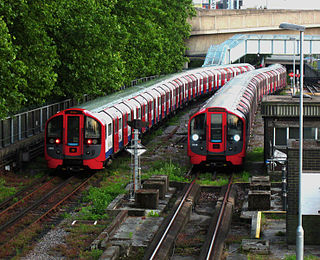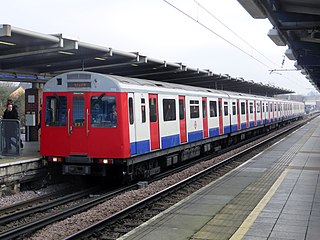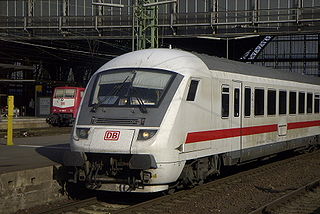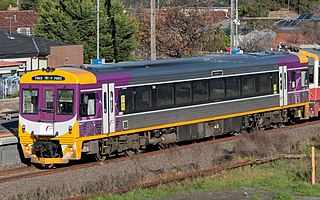
A conductor or guard is a train crew member responsible for operational and safety duties that do not involve actual operation of the train/locomotive. The conductor title is most common in North American railway operations, but the role is common worldwide under various job titles. In Commonwealth English, a conductor is also known as guard or train manager.

On trains, the expression emergency brake has several meanings:

London Underground rolling stock includes the electric multiple-unit trains used on the London Underground. These come in two sizes, smaller deep-level tube trains and larger sub-surface trains of a similar size to those on British main lines, both running on standard gauge tracks. New trains are designed for the maximum number of standing passengers and for speed of access to the cars.

The 4D was a prototype double deck electric multiple unit built for the Public Transport Corporation in Victoria, Australia, for operation on the Melbourne railway system. It remains the only double deck train to have ever operated in Melbourne. The train's name stood for "Double Deck Development and Demonstration."

The British Rail Class 166 Networker Turbo is a fleet of diesel multiple unit (DMU) passenger trains, built by ABB Transportation at their Holgate Road Works in York between 1992 and 1993. They were specified by and built for British Rail, the state-owned railway operator in Great Britain at the time. The trains were designed as a faster, air-conditioned variant of the Class 165 Turbo, intended for longer-distance services, and, like the 165s, belong to the Networker family of trains. They are known as Networker Turbos to distinguish them from the electrically propelled members of that family. Today the 166s, alongside the 165s, are normally referred to as Thames Turbos, the Networker Turbo Express or just simply Turbos.

The British Rail Class 222 Meridian is a diesel-electric multiple-unit high-speed passenger train capable of 125 mph (200 km/h). Twenty-seven sets were built by Bombardier Transportation in Bruges, Belgium.

The British Rail Class 444 Desiro is an electric multiple-unit passenger train built by Siemens Transportation Systems in Austria between 2002 and 2004. The Class 444 currently operate on express passenger services for South Western Railway.

The Harris trains were the first steel-bodied electric multiple unit (EMU) trains to operate on the suburban railway network of Melbourne, Victoria, Australia. They were introduced in 1956, by the Victorian Railways, and last operated in 1988, although a number of the carriages were converted for other uses and are still operating. They were named after Norman Charles Harris, Chairman of Commissioners of the Victorian Railways, between 1940 and 1950.

The London Underground D78 Stock, commonly referred to as D Stock, was a type of sub-surface rolling stock which operated on the District line of the London Underground, except on the Wimbledon to Edgware Road service. The first units were withdrawn in January 2015 with the last withdrawn on 21 April 2017.

The British Rail Class 318 is an electric multiple unit (EMU) passenger train which operates in west central Scotland. The units were introduced on 29 September 1986 as part of the electrification of the Ayrshire Coast Line between Glasgow Central and Ayr/Ardrossan with alternating current (AC) overhead lines. Their use was extended to Largs in January 1987. They were also used on the Inverclyde Line in small numbers. The trains currently operate Argyle Line, Cathcart Circle Line, North Clyde Line, Whifflet Line and Inverclyde Line services. Following the withdrawal of the Class 314 fleet in 2019, these units are the oldest working EMUs in Scotland, having been in revenue-earning service for more than 37 years.

The NSW TrainLink H sets, also referred to as the OSCAR trains, are a class of electric multiple units currently operated by NSW TrainLink. Built by UGL Rail in Broadmeadow, the H sets first entered service under the CityRail brand in December 2006, with the last in December 2012. Their introduction allowed for the retirement of some V set carriages. As long-distance trains, the H sets share a similar overall layout and design to the previous G sets. Currently operating as 55 four-carriage sets, the H sets now operate between Sydney, Central Coast and Newcastle and between Sydney and the South Coast.

A control car, cab car, control trailer, or driving trailer is a non-powered rail vehicle from which a train can be operated. As dedicated vehicles or regular passenger cars, they have one or two driver compartments with all the controls and gauges required to remotely operate the locomotive, including exterior locomotive equipment such as horns, bells, ploughs, and lights. They also have communications and safety systems such as GSM-R or European Train Control System (ETCS). Control cars enable push-pull operation when located on the end of a train opposite its locomotive by allowing the train to reverse direction at a terminus without moving the locomotive or turning the train around.
The 1920 Tube Stock consisted of forty cars built by Cammell Laird in Nottingham, England. These cars were the first new tube cars to be built with air operated doors. The batch consisted of twenty trailer and twenty control trailer cars, which were formed into six-car trains by the addition of twenty French motor cars built in 1906 and modified for air-door operation. They initially ran on the Piccadilly tube, but in 1930 were considered to be drab, compared to new stock being delivered at the time. The motor cars were therefore replaced by Standard Stock units, built in 1927, and the 1920 cars were refurbished. They were transferred to the Bakerloo line in 1932, and continued to operate until 1938.

The Wairarapa Connection is a New Zealand interurban commuter rail service along the Wairarapa Line between Masterton, the largest town in the Wairarapa, and Wellington. It is operated by Wellington suburban operator Transdev under contract from the Greater Wellington Regional Council. It is a diesel-hauled carriage service, introduced by the New Zealand Railways Department in 1964 after passenger demand between Masterton to Wellington exceeded the capacity of the diesel railcars then used.

The Changi Airport Skytrain is an automated people mover (APM) that connects Terminals 1, 2 and 3 at Singapore Changi Airport. Opened in 1990, it was the first driverless and automated system of its kind in South East Asia. The Changi Airport Skytrain operates from 05:00 to 02:30 daily. Traveling on the Skytrain is free and an inter-terminal journey takes approximately four minutes.

The Tait trains were a wooden bodied electric multiple unit (EMU) train that operated on the suburban railway network of Melbourne, Victoria, Australia. They were introduced in 1910 by the Victorian Railways as steam locomotive hauled cars, and converted to electric traction from 1919 when the Melbourne electrification project was underway. The trains derived their name from Sir Thomas James Tait, the chairman of commissioners of the Victorian Railways from 1903 to 1910. The first cars were built during 1909 with the last entering service in 1952.

The Sprinter is a diesel railcar built by A Goninan & Co in Broadmeadow, NSW for V/Line between 1993 and 1995.

The British Rail Class 331 Civity is a class of electric multiple unit built by CAF, owned by Eversholt Rail Group, and currently operated by Northern Trains. A total of 43 units have been built – 31 three-car units and 12 four-car units. Construction of the trains started in July 2017 and they were phased into service from 1 July 2019.

The British Rail Class 195 is a class of diesel multiple-unit passenger train from the Civity family manufactured by CAF, owned by Eversholt Rail Group and currently operated by Northern Trains. A total of 58 units have been built; 25 two-car units and 33 three-car units. The class is almost identical to the Class 331 also produced by CAF, which is the electric version of the Class 195, differing only in traction type and vehicle formation.
This article outlines the history and types of passenger rolling stock and guards vans on the narrow-gauge lines of the Victorian Railways in Australia. The types were constructed in parallel with very similar designs.

















